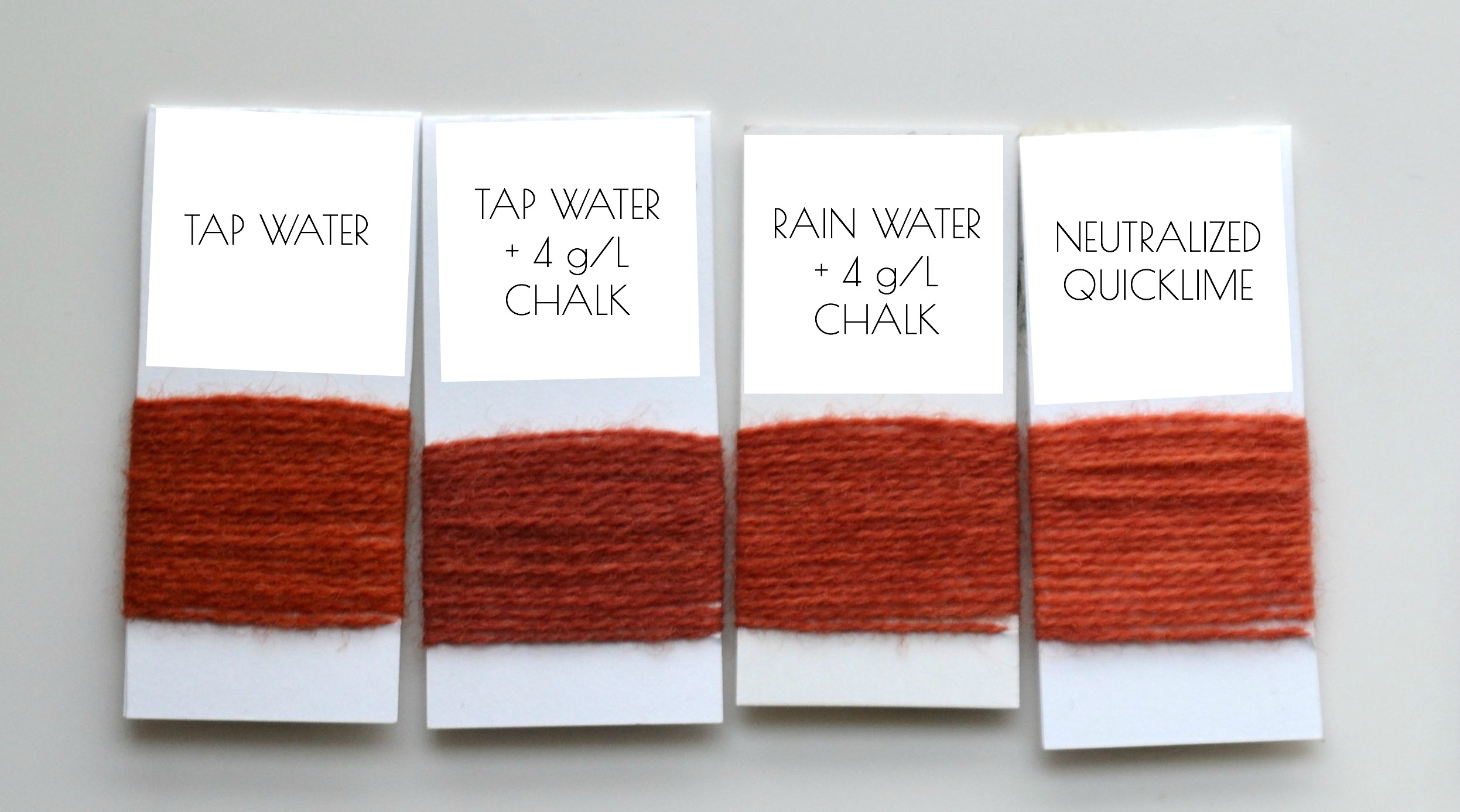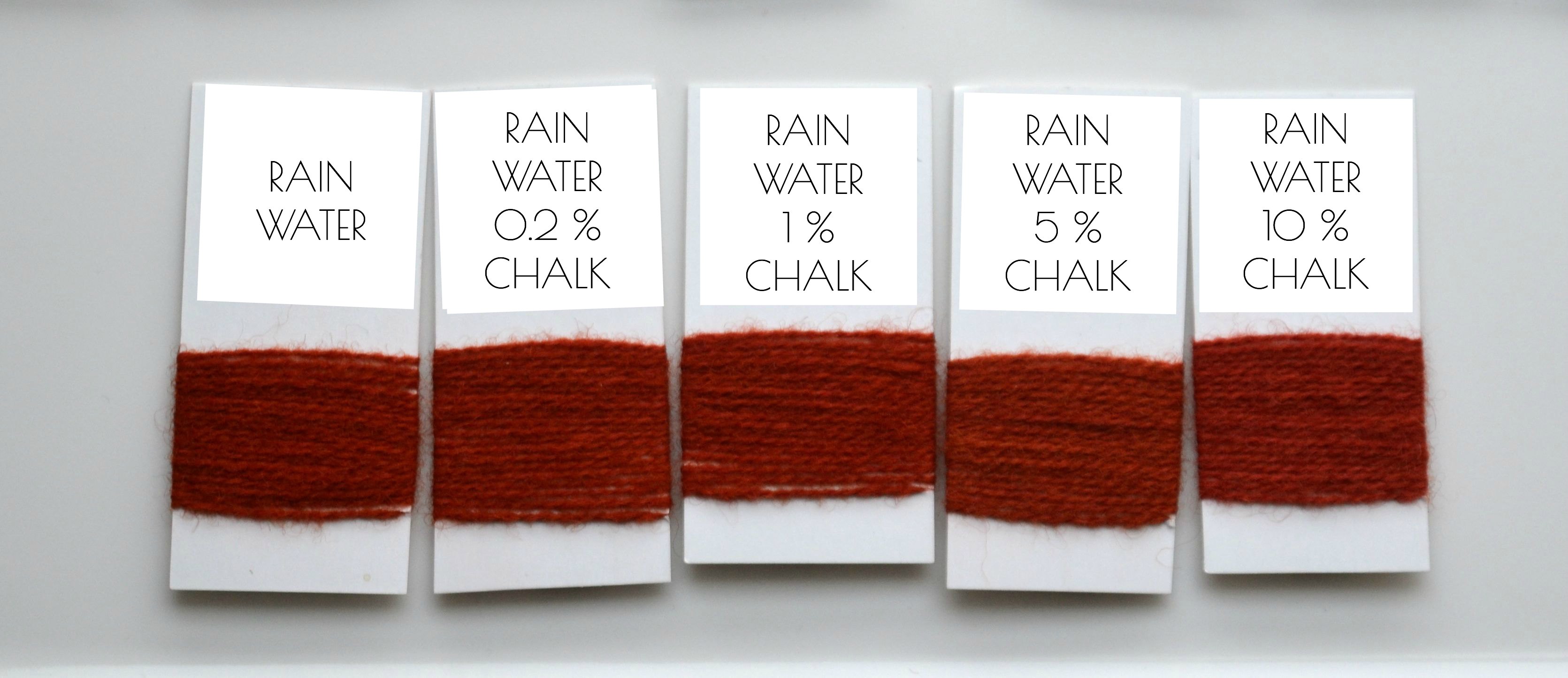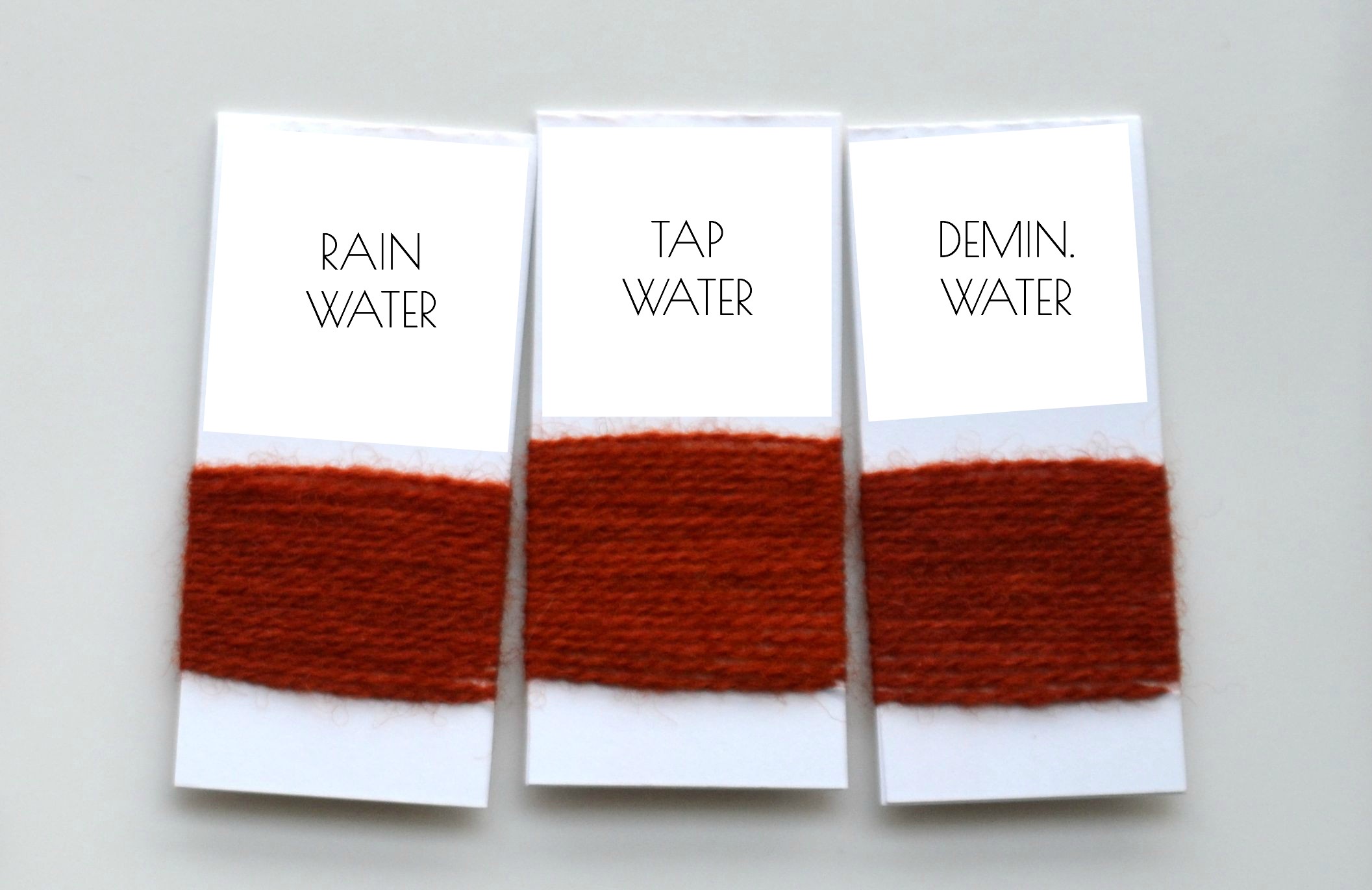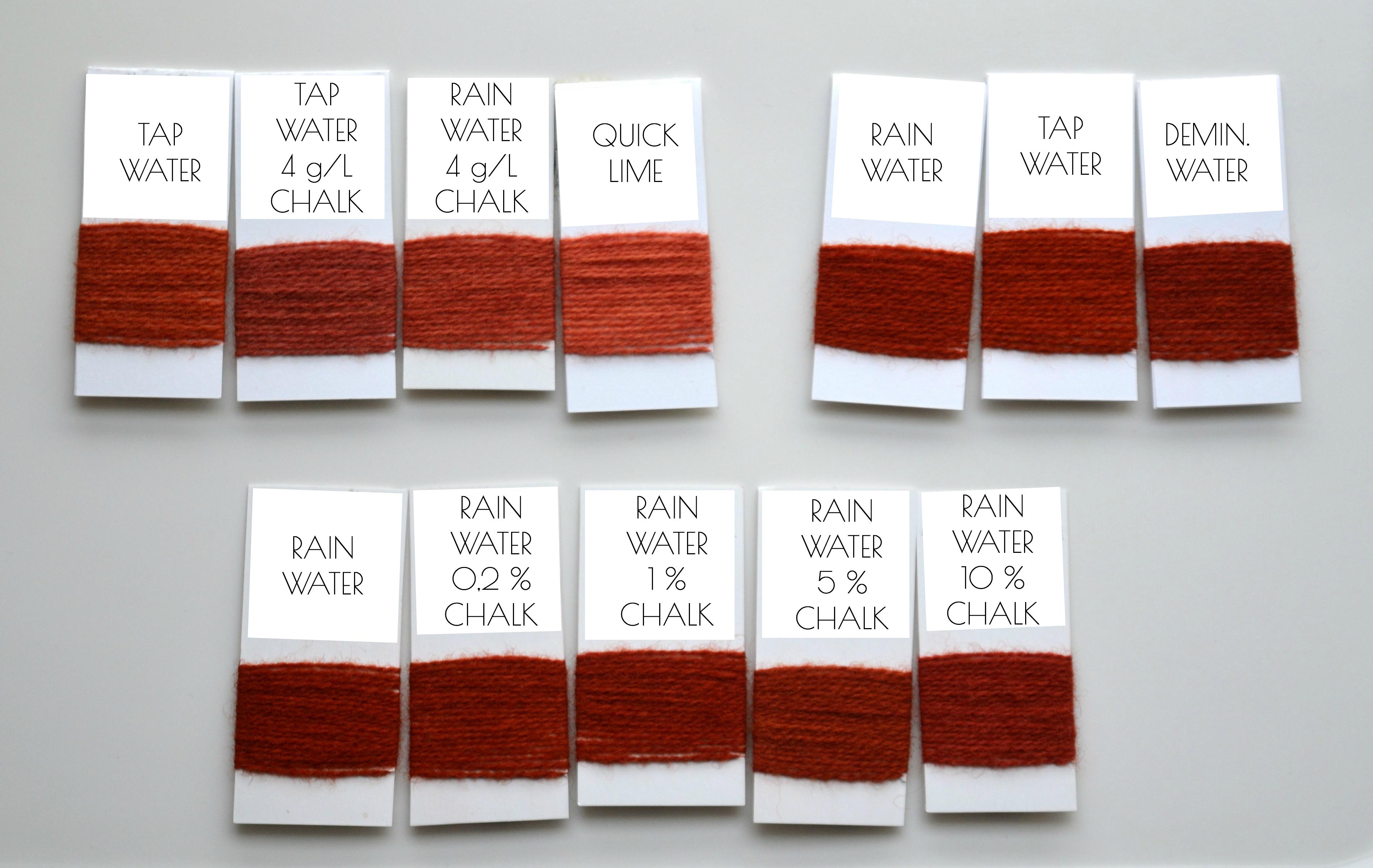Most sources agree that you need chalk to unlock the true reds of madder. I’ve always had a difficult time reconciling that with my own results, so experiments were called for.
~
I spent the past summer with a lot of experimental dyeing, and one of my themes was how chalk affects madder red.
Earlier in the year, I had experimented to see if I could remove the yellow tones from madder by soaking the madder in hot or cold water and discarding that water before dyeing (extraction) but according to my experiments, that’s not possible.
So the problem remained: sometimes I get a nice saturated red, other times a less saturated, more orange tone, although I use the same dyeing method.
My earlier experiments didn’t show a large difference between reds from rain water and tap water. The red with rain water is only slightly better than the one with tap water, but that is because the tap water is soft here.
But I have heard from several other Danish dyers that they have hard tap water, and that destroys the madder reds for them. I’ve also seen that myself where I used to live before, in a place with hard water.
This observation is quite consistent – but – is directly contradicted by a large body of work by many different authors, of mostly English-language dyeing books. Here’s a small selection from different authors:
“Chalk or slaked lime is added, particularly in areas with soft water.” John & Margaret Cannon: Dye Plants and Dyeing, p. 76.
“Add a tablespoon of ground limestone or chalk dust.” Rita Buchanan: A Dyer’ Garden, p. 52.
“If the water is deficient in lime, brighter shades are got by adding a little ground chalk to the dye bath.” Ethel Mairet: Vegetable Dyes, p. 42.
“Powdered chalk or limewater should be added to the dye-bath if the madder is ‘acid’.” Quote from Hellot’s “Art de la teinture des laines et étoffes de laine” in Dominique Cardon: Natural Dyes, p. 113.
I could go on like this. Source after source points out that chalk should be added. Some say if there is not “enough” or ir if the madder is “acid”, others just always add it.
It’s not clear where the idea comes from, but it seems to have been in circulation for a very long time. Hellot, quoted by Cardon, published his “Art de la tenture” in 1750, and it has been a very influential book.

In order to understand the effect of madder and chalk, I carried out a series of dyeing experiments on wool.
In all experiments, the proportion of madder to wool was 1:1, and I dyed at approx. 55 degrees C. I let the madder soak in water overnight, then dyed in that dye bath. During dyeing, I held the temperature for an hour, then let the yarn cool off in the bath until the next day.
First, I wanted to find out if it is chalk in tap water that affects the madder color, or something else. And by “something else”, I mostly mean iron, which may be present in tap water, and can affect colors a lot, when present even in small amounts.
For comparison, I began by dyeing a skein in tap water.
Then, I added chalk (from a garden center) in the amount of 4 g/L. That corresponds to about 2 Tsp in 10 L of water, giving a very slightly elevated pH of 7-8 instead of plain 7. The amount was just a guess, at that point in my experiments, I didn’t have a good idea of how much to use. I tried adding that amount both to tap and rain water.
Finally, I tried quicklime, which is a very strong base. So I neutralized it with a strong acid, since base destroys wool.
The results from that first round are below. On the left, yarn dyed in tap water, a paler red, the usual shade with tap water. When I add chalk to tap water, the color darkens slightly, just slightly. With rain water and chalk, the color is a bit lighter that with tap water alone, but very similar. So the conclusion so far is that chalk is the component in tap water that affects the color, not something else like iron.
But to be more sure, and having read that chalk for the garden can contain iron, I also tested quicklime. Calcium in tap water and in chalk for the garden is CaCO3 (calcium carbonate). Quicklime, on the other hand, is Ca(OH)2 (calcium hydroxide), a strong base. It was impossible to measure accurately, so I just took some of the chalky water in my bucket of quicklime and added it to demineralized water. This way, no other metals or minerals are present. I then neutralized the quicklime with a strong acid (I don’t remember which one).
The result of the quicklime experiment is seen at right. A very dusty pale red. So my conclusion so far is that yes, chalk has an effect, which is to make madder red paler and dustier, not more intense red. And yes, the component of tap water to affect the color is chalk. And the more of it (the harder the water), the larger the effect.

After this first round of experiments, I started thinking that I had added too much chalk. It might just be that there was a good effect at a certain low amount, but that too much chalk added could ruin the color. Having searched through my entire dye library, I finally found the figure 1-2% mentioned by Mairet. Most books just give nonsensical directions such as “a spoonful per dye pot”.
In order not to miss the sweet spot, I tested addition of 0.2, 1, 5, and 10% chalk. The result below was not entirely what I had expected. There really is no difference between dyeing in pure rain water and adding up to 5% chalk. The color began changing very slightly at 10% added (becoming paler) but the difference is so small that the photo does not capture it.

I couldn’t really decide if this was a good or bad result. Chalk in relevant amounts does not have an effect. It does not help unlock the good reds, but it also doesn’t do any harm.
But if all the English-language dyeing books are wrong, are the Danish dyers then right? Does the red color improve with less chalk? Below, a comparison of madder dyeing in rain water, tap water, and demineralized water. There is the usual difference between rain and tap water, the former giving the better red.
I took extra care with the yarn dyed in demineralized water. After mordanting, done in tap water as usual, I washed the yarn in rain water several times, and also cleaned the glassware for dyeing in rain water. That treatment gave the best red in the entire experiment, so I have to conclude that less chalk gives better red.

Below, I’ve shown all the colors in one picture so it’s easy to compare them.

So my result is very clear – less chalk gives better reds. But one mystery does remain. Why do all dyeing books from the last 3 centuries state that madder gives better reds when chalk is added?
It may be the fiber. The account I’ve seen was about cotton. When the Haussmann brothers moved their cotton printing business from Rouen (which has hard water) to Logelbach in 1775, the same dye processes that had produced brilliant reds in Rouen produced dull colors (“rouge terne”) in Logelbach. Brother Jean-Michel, the company’s chemist, did experiments and found that the problem was insufficient calcium in the local water and solved the problem by adding chalk.(The sources for this are not English-language but, rather, in French.)
Hi Virginia,
Thank you so much for your comment. I remember reading about that, but I just could not find it again in any of my books!! Would you be able to give a reference for the description? (even if it is in French… I can spell my way through a little bit of French if very motivated).
It sounds to me like the instructions about madder and chalk on wool are just the classical example of people copying incorrectly from old dye books. And once something is in print, everybody else copies it. Almost every time I test such hand-me-down instructions, I just cannot prove them correct.
Best,
Astrid
Hi Astrid,
Thanks for these great tests, so interesting! I have very mixed results with madder, some being so much more orange than others, probably depending on in what soil the madder was grown, as chalky soils result in better reds.
Could you tell us how you mordanted your wools before dyeing please? I am guessing you only used alum, but could you confirm if you used any cream of tartar too, please?
Thanks,
Carla in Cornwall, UK
And can I ask how you demineralize water? No idea how to do that, but with such a
Hi Carla,
Thank you very much!
Yes, I think you are correct. Madder grows better in chalk-rich, slightly alkaline soil, and this may very well be the main role of chalk in producing good reds, not in the dye bath itself.
I did mordant with alum only, I always use 10%, as using more has not given me better results, so it would just be wasteful.
I just buy demineralized water at an auto store, I believe it has some use related to car batteries…
Best, Astrid
Maybe the water they used in the past was not treated the same way as your tap water? Maybe is was more acid? I know our tap water is treated to come out almost neutral. Especially if you are finding this in only English dye books. In England they water may have been treated to be more acid requiring it to be based out for a dye bath? This could be how it was started and then dyers jus kept saying it in their recipes…
Good point about water, there would clearly be differences. I don’t think it is simply a quiestion of pH, though. At some point I tried dyeing with madder at different pH’s, and they made the dyebath change color but did not change the final color of the wool! But, it clearly got started and then copied and copied 🙂
Hi Astrid, thank you for sharing this journey with us! I am wondering if it is temperature related as well? I’m reading that temp impacts the red in Trudy Van Stralen’s book “Indigo, Madder &Marigold”
What temp did you use?
Thanks!